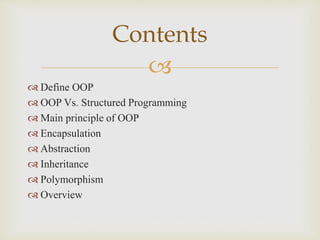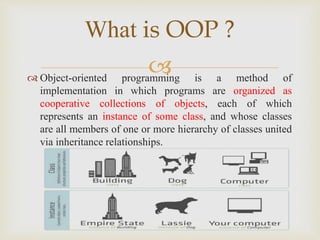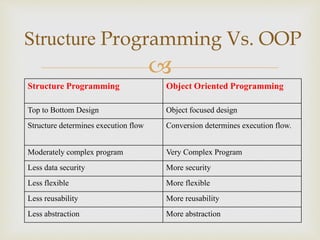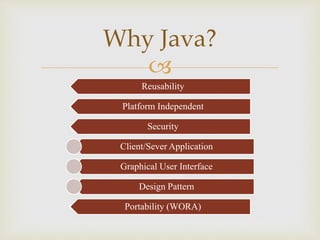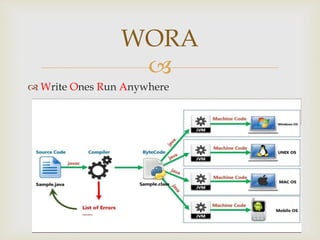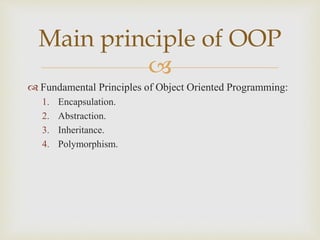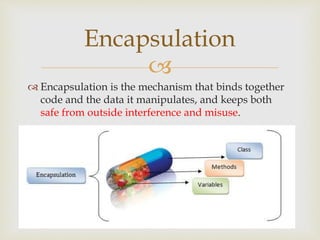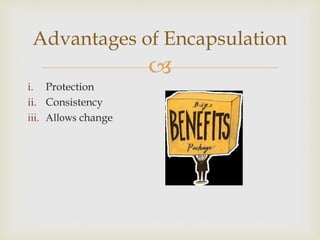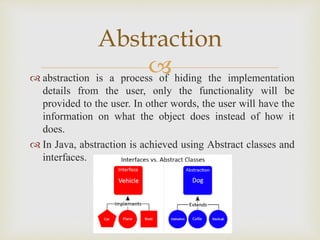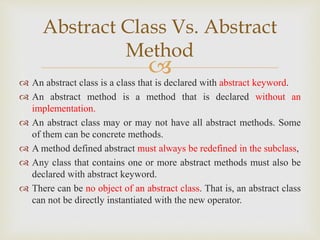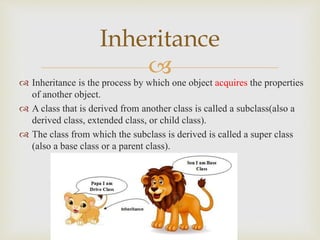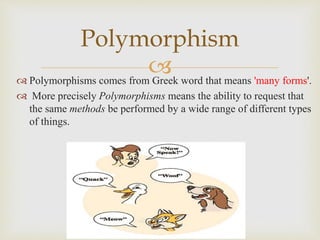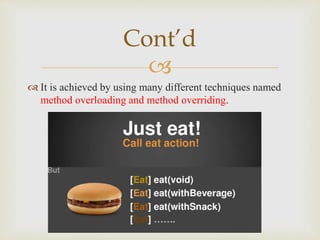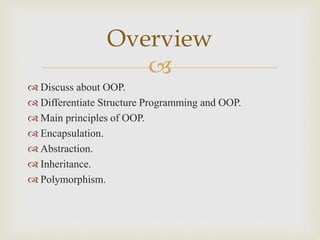OOP Introduction with java programming language
- 1. Md. Al-Imran Lecturer Department of Computer Science & Engineering Dhaka International University Bangladesh
- 2. ’é¢ ’éÖ Define OOP ’éÖ OOP Vs. Structured Programming ’éÖ Main principle of OOP ’éÖ Encapsulation ’éÖ Abstraction ’éÖ Inheritance ’éÖ Polymorphism ’éÖ Overview Contents
- 3. ’颒éÖ Object-oriented programming is a method of implementation in which programs are organized as cooperative collections of objects, each of which represents an instance of some class, and whose classes are all members of one or more hierarchy of classes united via inheritance relationships. What is OOP ?
- 4. ’é¢ Structure Programming Object Oriented Programming Top to Bottom Design Object focused design Structure determines execution flow Conversion determines execution flow. Moderately complex program Very Complex Program Less data security More security Less flexible More flexible Less reusability More reusability Less abstraction More abstraction Structure Programming Vs. OOP
- 5. ’é¢ Reusability Platform Independent Security Client/Sever Application Graphical User Interface Design Pattern Portability (WORA) Why Java?
- 6. ’é¢ ’éÖ Write Ones Run Anywhere WORA
- 7. ’é¢ ’éÖ Fundamental Principles of Object Oriented Programming: 1. Encapsulation. 2. Abstraction. 3. Inheritance. 4. Polymorphism. Main principle of OOP
- 8. ’é¢ ’éÖ Encapsulation is the mechanism that binds together code and the data it manipulates, and keeps both safe from outside interference and misuse. Encapsulation
- 9. ’é¢ i. Protection ii. Consistency iii. Allows change Advantages of Encapsulation
- 10. ’颒éÖ abstraction is a process of hiding the implementation details from the user, only the functionality will be provided to the user. In other words, the user will have the information on what the object does instead of how it does. ’éÖ In Java, abstraction is achieved using Abstract classes and interfaces. Abstraction
- 11. ’é¢ ’éÖ An abstract class is a class that is declared with abstract keyword. ’éÖ An abstract method is a method that is declared without an implementation. ’éÖ An abstract class may or may not have all abstract methods. Some of them can be concrete methods. ’éÖ A method defined abstract must always be redefined in the subclass, ’éÖ Any class that contains one or more abstract methods must also be declared with abstract keyword. ’éÖ There can be no object of an abstract class. That is, an abstract class can not be directly instantiated with the new operator. Abstract Class Vs. Abstract Method
- 12. ’é¢ ’éÖ Inheritance is the process by which one object acquires the properties of another object. ’éÖ A class that is derived from another class is called a subclass(also a derived class, extended class, or child class). ’éÖ The class from which the subclass is derived is called a super class (also a base class or a parent class). Inheritance
- 13. ’é¢ ’éÖ The sub-class inherits the base classŌĆÖ data members and member functions. ’éÖ A sub-class has all data members of its base-class plus its own. ’éÖ A sub-class has all member functions of its base class (with changes) plus its own. ContŌĆÖd
- 14. ’é¢ Inheritance has a lot of benefits ’éÖ Extensibility ’éÖ Reusability ’éÖ Provides abstraction ’éÖ Eliminates redundant code ’éÖ Use inheritance for building a relationships E.g. dog is--a animal (dogs are kind of animals) Benefits of Inheritance
- 15. ’颒éÖ Polymorphisms comes from Greek word that means 'many forms'. ’éÖ More precisely Polymorphisms means the ability to request that the same methods be performed by a wide range of different types of things. Polymorphism
- 16. ’é¢ ’éÖ It is achieved by using many different techniques named method overloading and method overriding. ContŌĆÖd
- 17. ’é¢ ’éÖ Discuss about OOP. ’éÖ Differentiate Structure Programming and OOP. ’éÖ Main principles of OOP. ’éÖ Encapsulation. ’éÖ Abstraction. ’éÖ Inheritance. ’éÖ Polymorphism. Overview


